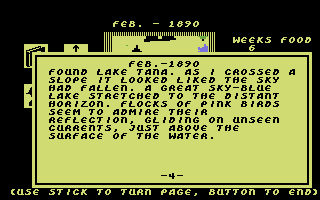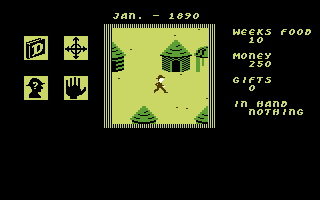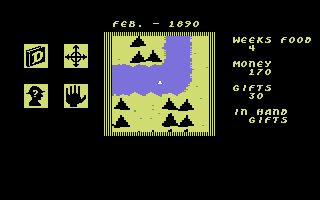Retro Replay Review
Gameplay
Heart of Africa delivers a rich blend of exploration, resource management, and cultural negotiation. You begin at a bustling port town with just $250 in your pocket, scavenging for essential supplies like ropes, shovels, and trade goods. Every purchase must be weighed carefully, as running out of provisions in the vast African wilderness can leave you stranded with no clear path forward.
The adventure unfolds through a top-down exploration window where you guide your character with the joystick and interact via the fire button. A set of four icons—Diary, Map, Options, and Hand—allow you to pore over Hiram Primm’s unpublished notes, track your cartographic progress, stash supplies in hidden caches, and use inventory items. Managing delirium is another layer of challenge: if your explorer becomes dehydrated or malnourished, controls may invert or respond erratically, underscoring the importance of self-care in the field.
However, raw survival isn’t enough. Your success hinges on forging relationships with native tribes. Each group has its own cultural preferences, so offering gold to one chief might win favor, while presenting copper to another could spark offense. Learning to read subtle clues—be it the color of ceremonial attire or the carved symbols on a tribal emblem—turns diplomacy into a nuanced minigame of trial and error. Every new ally brings you closer to whispered hints about the lost tomb of Pharaoh Ahnk Ahnk.
Finally, replayability is baked into the design. The tomb’s location—and the surrounding treasures—shifts with each new game, encouraging you to experiment with different trading strategies, routes, and gift-giving approaches. Up to ten save files can be stored at a port city pub, making it easy to maintain separate playthroughs as you refine your tactics and chase ever-elusive clues.
Graphics
On platforms of its era, Heart of Africa impresses with vibrant, hand-drawn sprites that breathe life into pixelated plains, rivers, and tribal villages. Color palettes shift subtly between desert browns, savannah golds, and lush jungle greens, giving each region a distinct visual identity. While modern gamers might find the resolution dated, the artistry and care put into each environment remain evident.
Character and tribal chief portraits appear during dialogue sequences, rendered with surprisingly expressive detail despite limited color depth. You can almost read the skepticism in a chief’s furrowed brow or the excitement in your own explorer’s wide eyes as he uncovers a fresh clue. Animations for digging, climbing, and trading add an extra layer of immersion, ensuring that your in-game actions never feel static.
Maps and HUD elements are cleanly designed. The diary pages mimic yellowed parchment, and the map grid updates in real time as you explore. Icons for supplies and gifts are immediately recognizable—no guesswork is required when selecting between a bag of copper and a fistful of gold coins. Even if you’re playing on a modern emulator, the interface remains intuitive and faithful to the original vision.
Story
The narrative driving Heart of Africa hinges on the unfinished expedition of Hiram Primm, whose mysterious disappearance sets the stage for your own quest. Armed with only his African diary and a brief scholarly paper on Pharaoh Ahnk Ahnk, you must piece together the legend of a king long lost to time. This blend of historical fiction and speculative lore lends the game an air of genuine mystery.
As you traverse villages and negotiate with tribal elders, you gradually unlock fragments of Primm’s final days. Each diary entry reveals more about Ahnk Ahnk’s purported tomb—hidden chambers, cursed relics, and booby-trapped corridors. These story beats unfold organically through exploration rather than cutscenes, fostering a sense of discovery that few contemporary titles achieve.
Branching rumor systems keep the narrative fresh. A chief in one region might insist the tomb lies beneath a volcanic crater, while another hint at ancient river tunnels. Sorting fact from local legend becomes part of the storytelling itself, and you’ll find yourself cross-referencing diary notes with native testimonies to separate myth from reality. This interplay ensures that no two players experience the story in quite the same way.
Overall Experience
Heart of Africa stands out as a compelling blend of survival sim, strategy, and cultural RPG, all wrapped in a period-authentic presentation. Its core loop—gathering resources, negotiating alliances, and mapping uncharted territories—feels both challenging and endlessly engaging. The dynamic tomb placement and variable tribal reactions guarantee high replay value.
While the learning curve can be steep, especially when it comes to deciphering tribal gift preferences or managing your explorer’s health, the sense of achievement after uncovering even the smallest clue is immensely rewarding. Saving your progress at a port pub adds a welcome layer of security, but it also forces you to plan your expedition legs thoughtfully to avoid catastrophic setbacks far from civilization.
Graphical limitations of the era may deter players accustomed to modern 3D realism, yet those willing to look past the pixel grid will discover a game rich in atmosphere and historical intrigue. The seamless integration of gameplay mechanics with story elements makes every snippet of Primm’s diary feel consequential, and the threat of delirium or hostile encounters keeps tension high.
For fans of retro adventure titles and those who appreciate open-ended exploration, Heart of Africa offers a uniquely satisfying journey through untamed wilderness and human cultures seldom portrayed with such nuance in early gaming. It remains a hidden gem for collectors and indie developers seeking inspiration from a time when imagination drove every pixel on screen.
 Retro Replay Retro Replay gaming reviews, news, emulation, geek stuff and more!
Retro Replay Retro Replay gaming reviews, news, emulation, geek stuff and more!









Reviews
There are no reviews yet.